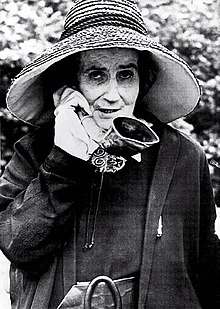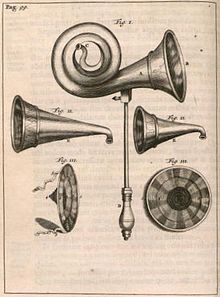Ear tube

Ear trumpets , formerly also known as hearing machines or sound beam catchers, are tubular or funnel-shaped devices that collect sound waves and guide them into the external auditory canal of the human ear . This made it possible to amplify the sound energy falling on the eardrum and thus improve hearing with reduced or declining hearing. Hearing trays were constructed from sheet iron , silver, wood, snail shells or animal horns.
history
In 1624 the Jesuit Jean Leurechon made the principle of the ear trumpet known for the first time in a printed work under the pseudonym H. van Etten . Athanasius Kircher , who, in addition to numerous other fields of knowledge, dealt with the theory of sound and described the invention of a “hearing machine” in his Musurgia in 1650 , is considered to be the actual inventor of the hearing tube. But there must have been ear trumpets much earlier, even if there is no picture of them. The doctor Archigenes (2nd century), who worked in Rome, mentioned an ear trumpet as a remedy for hearing loss, as did the Greek doctor Alexander von Tralles (5th century). A medieval miniature from the 12th century, now in the French National Library , shows King Arthur hunting with an ear trumpet. In 1706, Jacques Joseph Duguet used tubes built into the armrests of an armchair to receive sound waves. This arrangement found multiple imitations. In 1879, in Chicago, Rhodes constructed audio fans called “audiophones” from natural mussel shells , with which the sound vibrations were transmitted via bone conduction by holding the fan against the teeth or between the teeth. From 1812 to 1814, Johann Nepomuk Mälzel made hearing traps for Ludwig van Beethoven , which are now exhibited in the Beethoven Museum in Bonn. In 1816, René Laënnec in France reinvented the hearing tube as a stethoscope for listening to heart sounds. The Kirchner & Wilhelm company in Asperg near Stuttgart offered numerous hearing tube models in the catalog of the "Medical Warehouse" in 1910. The company FC Rein and Son from London was the last to stop the production of hearing traps in 1963.
During the world wars with the emergence of military aviation , attempts were made to build acoustic positioning systems using the hearing aid principle, see directional receiver , Japanese war tuba .
literature
- Franz Maria Feldhaus: The age of the hearing tube . In: European Archives of Oto-Rhino-Laryngology . tape 76 , no. 3-4 , 1908, ISSN 0937-4477 .
- Rainer Hüls: The history of hearing acoustics: 2000 years of hearing and hearing aids . Median-Verlag, Heidelberg 1999, ISBN 3-922766-66-8 .
- Rainer Hüls: The hand on the ear: A little history of hearing aids . Innocentia-Verlag, Hamburg 2009, ISBN 978-3-9808107-3-9 .
